
The swollen bulbs on these tentacles make it easy to see why Entacmaea quadricolor is called the bubble-tip anemone.
Several species of sea anemones are available to aquarium hobbyists, but the bubble-tip anemone (Entacmaea quadricolor) is certainly the most popular, and for good reasons. Unlike some other common anemones, this one can host numerous species of anemone/clownfishes and is relatively hardy, too. They can also be very attractive and usually don’t cost too much, either. This all makes for a good addition to an aquarium. However, they oftentimes have some annoying habits and can pose some problems. So, I’ll fill you in on the bubble-tip anemone, covering some basic information, which species of anemonefishes will reside in them, how to care for them, and a couple of problems they may cause.
The Basics
To start, while this species is called the bubble-tip anemone in the hobby, many of them don’t have bubble-tipped tentacles. While many of them do bear tentacles that have bubble-like swellings near their ends, many others lack the swellings, and instead have longer, thinner tentacles. These can easily be mistaken for a different species altogether, as they resemble most any other anemone with plain, long tentacles. Having or lacking bubbles isn’t always permanent either, as they may come and go in some cases. For the most part, specimens that have relatively short tentacles may or may not develop or retain the bubble-like swellings over time, while those with long, thin tentacles typically lack them entirely. To the best of my knowledge, exactly why they have or don’t have them hasn’t been figured out, either.
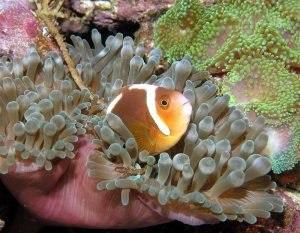
BTAs don’t host percula, ocellaris, or white-bonnet clowns in the wild, but these species will often move into them in aquariums.
Fautin and Allen (1992) did suggest that the formation of the bubbles was somehow elicited by the presence of anemonefishes, and that adding a suitable anemonefish could make a bubble-less BTA become a bubble-covered BTA. However, this certainly isn’t always the case, as I’ve seen lots of contradictory evidence in aquariums and while diving, too. Delbeek & Sprung (1997) instead suggested that the presence or absence of bubbles has do with lighting and that the bubbles disappear and the tentacles get longer and thinner under lower light, or that it may have something to do with an anemone being hungry. While I agree that BTAs kept under intense lighting in aquariums do seem to be more likely to keep their bubbles, or to develop them where there were none before, again, I’ve seen otherwise at times.
After being in the marine aquarium hobby and trade for almost 20 years, and diving many times around Indonesia, I’ve had a lot of experience with this particular anemone. Over that time I’ve seen BTAs without bubbles stay bubble-less even after an anemonefish has taken up residence in them. And, I’ve seen BTAs with bubbles loose them once established in an aquarium, despite having an anemonefish being introduced simultaneously and living in them, too. Likewise, I’ve seen some BTAs with bubbles living not just close to, but in direct contact with others that were bubble-less. And, I’ve seen a BTA situated lower in an aquarium (where the light is dimmer) maintain bubbles, while two others that sat higher in the tank (where the light is brighter) did not. So, it would be hard to convince me that presence or absence of the bubbles is strictly tied to the presence or anemonefishes or lighting. The same goes for hunger too, as I’ve kept many bubble-less BTAs well-fed and healthy without seeing any change. On top of all this, I once came across one very odd BTA while diving. It had some big, well-developed bubbles on some of its tentacles, while the others had none. I actually had to stop and poke around on the thing to be sure that it wasn’t two individuals living in contact with each other.
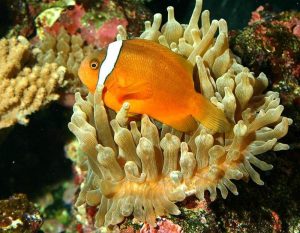
While anemonefishes can be attractive and fun to watch as they interact with a host anemone, their presence is not required to keep a BTA healthy.
So, the reason(s) that the bubbles may come and go are elusive to say the least. I can guess that there’s some combination of these factors that plays a role, but there could be many other things involved like lighting spectrum (as opposed to intensity only), water quality, water flow, genetics, etc. All I can say is that a healthy bubbled specimen provided with an anemonefish, good water quality, lighting, current, and food is very likely to keep its bubbles, but then again, it might not.
Anyway, BTAs come in a range of colors from brown to green and orangish to red, with the red ones often being called rose anemones. They can also vary greatly in size when mature, with some growing to no more than a few inches across and having relatively short tentacles, and others getting absolutely huge. The disc of occasional specimens may grow to over a foot across, and these can develop tentacles that are several inches long, too. So, they can potentially take up a whole lot of room in a tank.
Also note that BTAs are always found attached to solid substrates, and usually with their base down in a hole or crevice. When living in shallow waters they often occur in large groups and are tightly spaced, making some areas look like they’re covered by one giant anemone with thousands of tentacles. In such cases the anemones generally stay smaller and have shorter tentacles, but not all of them live in groves, as some live alone or in smaller groups.

At times, the tentacles may be bubble-less and then slowly develop them, as is happening here. Or, they may have bubbles and lose them.
This is especially true when they are living in deeper, dimmer waters, where they also tend to grow to larger sizes and indeed do have longer, thinner tentacles. Also note that while they prefer to attach themselves in a hole or crevice, I’ve seen them on exposed surfaces when nothing else was available, and they’ll even attach onto the glass in aquariums at times.
When it comes to reproduction, BTAs do have separate sexes. Some are male and some female, and they will spawn from time to time by releasing large numbers of sperm and eggs into surrounding waters. Some of these gametes will end up meeting each other, and once fertilization occurs, the eggs will develop into larvae. Then, these will eventually settle to the bottom and begin to grow into adult anemones, which can start the reproductive cycle all over. Note that while numerous hobbyists have reported that BTAs will spawn in aquariums, apparently none of the larvae survive to give rise to new anemones.
Sexual reproduction is important because it allows the genes of different anemones to mix, thus ensuring that there is some diversity in a population. But, BTAs can also reproduce asexually. Most other species of anemone only reproduce sexually, but BTAs can make more of themselves without the use of any sperm or eggs to produce genetic clones. They can do it frequently, too.
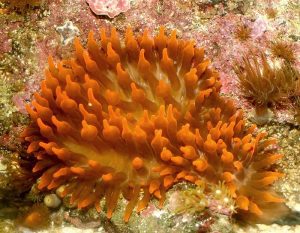 The most common means of asexual reproduction for these anemones is called longitudinal fission, which amounts to them splitting down the middle to make two anemones from one. A BTA that reproduces this way will begin to pinch in at two points opposite each other on their base, then will take on something of a figure-eight form (when viewed from above). Then the indentions will eventually draw closer and closer to each other until the whole thing just splits in two. After this, each new half will develop more tentacles and internal structures, and the two may move away from each other. This is also the only common form of reproduction in aquariums.
The most common means of asexual reproduction for these anemones is called longitudinal fission, which amounts to them splitting down the middle to make two anemones from one. A BTA that reproduces this way will begin to pinch in at two points opposite each other on their base, then will take on something of a figure-eight form (when viewed from above). Then the indentions will eventually draw closer and closer to each other until the whole thing just splits in two. After this, each new half will develop more tentacles and internal structures, and the two may move away from each other. This is also the only common form of reproduction in aquariums.
One thing you do need to note here is that you shouldn’t always assume that reproduction is associated with good health, though. To the contrary, BTAs may also split when they are stressed. While the exact reason isn’t clear, I’ve heard numerous reports of BTAs doing so right after a big water change, and I’ve also seen them reproduce this way just before bleaching (loosing their zooxanthellae due to stress), which is never a good sign. So, I’m under the impression that any significant change in water quality can bring on fission, as can over/under illumination, or an unacceptable rise or fall of temperatures.
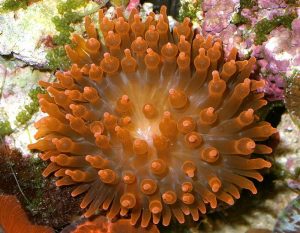
Some BTAs are red in color, and are typically called rose anemones whether they have bubbles or not.
While I’ve never seen it happen, according to Delbeek & Sprung (1997) BTAs may also reproduce asexually via pedal laceration at times. In this case, all that happens is a small bit of tissue separates from the base of a parent and then grows into a new anemone. So, there’s a chance that you might find some tiny new BTAs showing up around the base of an adult, too.
Compatible Anemonefishes
An anemone’s tentacles are covered by numerous stinging cells called cnidocytes, and these cells fire tiny harpoon-like structures into prey when contact is made. The threaded harpoons then inject venom into the victim in order to immobilize and/or kill it. However, they don’t react to everything they touch, as the tentacles and cnidocytes don’t sting rocks, sand, and other non-fleshy items in their surroundings. These things do not have the right chemical makeup to be identified as “meat” and elicit a sting response.
While numerous ideas have been proposed over the years, it has been shown that, like a nearby stone, anemonefishes aren’t recognized as being meat either, so they don’t get stung. Like other fishes, these produce a coating of slime on their bodies, and in their case it either includes chemicals that make an anemone think they’re part of the anemone, or conversely, it lacks chemicals that would let an anemone know they are meat (or both). To date there is no definitive answer for every case, but the bottom line is that anemonefishes don’t get stung, while almost all other fishes do.
With that in mind, it should be easy to see that an anemonefish’s ability to mingle amongst an anemone’s tentacles makes for quite a defense against being eaten. In fact, this protection is beneficial enough that they have come to depend on anemones as hosts and they’re always found living with them in the wild, rarely wandering very far away. In return, in many cases the fishes keep things away that may prey upon the anemones, and in aquariums you may also see one take excess food to an anemone and actually feed it.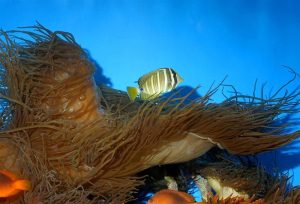
There’s a catch though, as each species of anemone will only host a particular list of anemonefishes. It isn’t a free-for-all between the two, so you’ll only see certain species of fishes living with certain species of anemones. Typically, if the wrong species of anemonefish was to attempt to enter the wrong species of anemone, it would be treated just like any other fish and get stung. However, do note that this rigid selection sometimes isn’t so rigid in aquariums. For whatever reason, match-ups not observed in the wild are often encountered in aquariums. So, it seems that when no regular host anemone is present, some anemonefishes will make due with something else. I’ve never found an explanation of how they get away with this, but sometimes they’ll develop relationships with various stinging corals, too.
Anyway, when it comes to BTAs, more species of anemonefish can pair up with them than with any other species of anemone. Fautin and Allen (1992) report that BTAs in the wild will host the common maroon clown (Premnas biaculeatus), the tomato clown (Amphiprion frenatus), the fire clown (A. ephippium), the cinnamon clown (A. melanopus), and the clarkii clown (A. clarkii). And, they’ll also welcome the company of the less-common species A. akindynos, A. allardi, A. bicinctus, A. chrysopterus, A. mccullochi, A. omanensis, A. rubrocinctus, and A. tricinctus, too.
In addition to all of these, I’ve also seen them play host to the percula clown (A. percula), the false percula clown (A. ocellaris), and the white-bonnet clown (A. leucokranos) in aquariums. None of these three are found with BTAs in the wild, but I don’t think I’ve ever had one of these species refuse to move into one in an aquarium.
Still, an anemomefish isn’t required by any means. In the wild, these fishes can help prevent their host anemones from being eaten or preyed upon by other fishes or critters, but in an aquarium free of predators, there’s no need for a partner other than your own enjoyment. I’ve had several BTAs with no anemonefish living in them and seen no adverse effects at all.
Shopping and Aquarium Care
When it comes to shopping, you should obviously go for the healthiest specimen(s) available. Look for BTAs that are firmly attached the substrate or glass, and are well expanded. If a specimen looks shriveled up, or if its tentacles are drooping straight down, don’t buy it. You should also check for any signs of injury, and need to take a look at the mouth, too. It should never be gaping open, as a healthy specimen will have its mouth closed up, and usually somewhat puckered. I would also stay away from really large specimens and try for something that has a body that is less than three or four inches in diameter. These small/medium size specimens tend to ship much better than large ones, and they can grow quickly anyway.
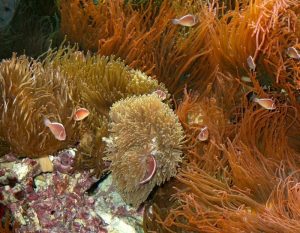
Once they get going, BTAs can literally fill an aquarium over time, just as they would cover significant areas of seafloor in the wild.
Other than that, you should also watch very closely when a BTA is being removed from a holding tank and bagged up for the trip home. Healthy ones will be firmly attached, so this means they can also be difficult to remove. A specimen must be very carefully peeled off glass without tearing the flesh, and if they are attached to a rock, the rock should just go with them.
If at all possible, you should also try to find an aquacultured specimen. They’re out there and available, and I think it’s always best to purchase livestock that has been produced and reared in captivity rather than taken from the wild. Shimek (undated) makes an especially good case for this with respect to anemones, pointing out that populations can have difficulty recovering after harvesting and that all associated anemonefishes, anemone crabs, and anemone shrimps are left homeless. Apparently, these animals can’t simply move to another anemone either, as they’re typically already populated by others.
When it comes to care at the house, it should go without saying that you need good water quality to keep BTAs at their best, and they’ll need high-output lighting, too. Metal halide lighting is wonderful, but really it isn’t required, as BTAs can thrive under a set of VHO, PC, or T5 fluorescent bulbs, as well as LED lighting. I’ve heard of some hobbyists keeping them long-term under normal-wattage bulbs, but in my experience BTAs will move to the top of a tank under such dim conditions, then slowly wither away until they’re removed (I tried it, more than once, unsuccessfully). Thus, I strongly recommend that you provide them with a high-output light source.
Also note that if you have any concerns that you might actually have lights that are too intense, all you need to do is place a BTA at the bottom of a tank in the rockwork and let it slowly adapt to your lights on its own schedule. They do move around when they want, so if they’re getting too much light they’ll hide from it and stay in relatively dim areas of a tank, or try to move themselves up if they aren’t getting as much as they need.
Placement is easy, as you only need to put them on a hard substrate and let them do the rest, as they’ll move if they don’t like the spot you’ve chosen, slowly crawling around in an attempt to find a spot that is more suitable. The same applies to providing them with suitable water flow, too. You can put them just about anywhere other than right in front of a powerhead or pump return, and they’ll move around to a better spot if they aren’t happy with your choice.
While I know that some hobbyists don’t feed BTAs, I highly recommend that you do so if you expect them to really thrive. At least once a week you should give a BTA a small serving of chopped up fish, shrimp, or clam meat, or some brine shrimp. You can do this by hand, or you can use a turkey baster to give them a squirt of stuff in the tentacles, but never try to squirt food directly into the mouth. Using various sorts of particulate foods suitable for corals can help, as well. Still, there are times when a BTA will refuse to take food, or will only take part of what you offer and let the rest go. Not to worry though, just cut back on the frequency and/or amount offered and see what happens.
By the way, there’s no reason at all to think that you need a full-blown reef aquarium to keep these. In fact, I’ve set up a several tanks that had only fishes, live rock, some sand, and BTAs and they were absolutely gorgeous. As long as none of the fishes are anemone eaters, the water quality is good, and the lights are adequate, there shouldn’t be any problems. If fact, this is probably the best way to go if you really like anemones and their partners.
Potential Problems
While BTAs may sound like a great thing to have at this point, there are a few potential negatives to think about before buying one. First of all, some may appear to be perfectly healthy and reproduce very slowly if at all, but at other times, under optimal conditions, BTAs can produce multiple copies of themselves every few weeks. Then, two can make four, and four can make eight, and so on. So, their reproductive abilities can actually become a problem in a crowded aquarium, as they may begin to overrun other inhabitants. Likewise, they can also get rather large at times, meaning that they can still create space problems even if they don’t reproduce.
As mentioned, they can also move around if they feel the need, which may be a problem, too. Most corals and such seem to be resistant to the stings of BTAs, but being resistant to stings is not the same as being immune to them. Leather corals and such may never be bothered by a BTA, but other tank inhabitants, especially some small-polyped stony corals, may be injured if one wanders too close to them. This is why I said that if you love anemones, you may be better off setting up an aquarium dedicated to them, or at least lacking small-polyped stony corals.
A second problem can arise from their habit of moving around, as they occasional may get too close to a pump or filter intake and get sucked into it. I’d expect them to back off if they get too close to an intake, but that’s oftentimes not what happens. Instead, I’ve seen several specimens basically allow themselves to be slurped well up into the screening (when present). This is usually fatal if they stay in it long, so the best thing to do is to remove the equipment and place it in a bucket of tank water, then let the anemone back out of it on its own if it’s still alive.
References
- Delbeek, J.C. and J. Sprung. 1997. The Reef Aquarium: Volume Two. Ricordea Publishing, Coconut Grove, FL. 546pp.
- Fautine, D.G. and G.R. Allen. 1994. Anemone Fishes and their Host Sea Anemones. Tetra-Press, Mella, Germany. 157pp.
- Shimek, R.L. undated. Be a Host to Your Anemone. URL: http://www.reefland.com/rho/0505/main4.php


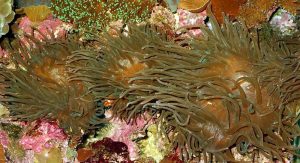

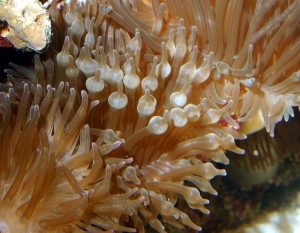

0 Comments